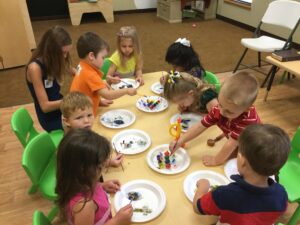
Baby Sleep Training
Young babies need 12 to 13 hours per day to sleep and by six months, most sleep 11 to 12 hours total according to Dr. Richard Ferber, author of Solve Your Child’s Sleep Problems.
Sleep training is the answer to getting your baby to sleep through the night. Know what’s going on with your baby and make a plan for baby sleep training that you faithfully follow.
- Keep the room slightly cool,
- Turn the lights off
- Always put your baby to sleep on her back,
- Use a swaddle blanket or sleep sack avoid loose balnkets
Know when your baby is able to sleep through the night.
By three months, or once a baby weighs about 12 pounds, they are usually physically able to sleep through the night.
Is your baby is waking up and only eating a few sips? Maybe’s she’s not really hungry and you might want to try to you skip that feeding.
Realize when a bad habit is setting in.
If your baby is waking up but only taking a little milk or formula, chances she’s not really hungry. By feeding her when she’s not really hungry you are encouraging waking to eat and are prolonging the time it will take to train her to sleep through the night.
Let your baby fall asleep in her crib or sleep space.
You want your baby to learn to fall asleep on her own, and she won’t be able to learn how to if you’re rocking her to sleep. You can rock baby but once she’s groggy put her down, encouraging her to fall asleep on her own in her own space.
If your baby awakes and doesn’t need to eat, don’t pick her up.
Reassure your baby, gently pat her on the back and whispering “I’m here”. Don’t turn the lights on.
Once your baby has calmed down, but still awake, leave the room. If your baby cries again, wait a few minutes, and repeat the steps above.
Continue waiting a few more minutes each time before going to her when she cries, this encourages her to learn to fall back to sleep on her own.
Babies who have good sleep habits are less fussy. Help your baby to get the sleep she needs by creating good sleep habits and a peaceful environment early on.
























